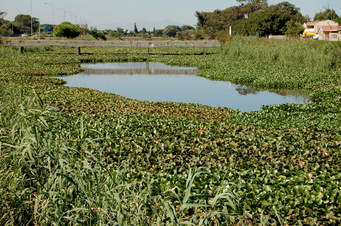By James Adika
Mechanical removal of Water Hyacinth has started in Lake Victoria .
Economic activities around Lake Victoria are expected to improve following this introduction of a 8 million Ksh machine for removal of a weed that has been a menace to the lake.
The programme has been started by the Kenya Maritime Authority (KMA), who hired the machine from the National Water Conservation and Pipeline Corporation as a measure to contain the weed that has deprived fisher folk of their livelihood.
The head of maritime safety at KMA, Wilfred Kagimbi, said the machine will operate in the area for next one month and three weeks but they are likely to relocate if the weed moves elsewhere.
“We are yet to determine the amount of water hyacinth this machine can remove in a day because it has not served this purpose before,” Kagimbi said.
The machine will not eradicate the hyacinth from the entire lake within the stipulated time, but it is aimed at encouraging organizations charged with the responsibility of controlling the weed to use mechanical removal methods.
“There are many organizations concerned with the removal of water hyacinth. We may not be able to remove the weed from the entire lake but our main aim is to demonstrate that mechanical removal can be successful,” Kagimbi clarified.He added that past methods had failed.
While flagging off the machine at Kamwala Beach in Rachuonyo North Sub-County, Homa Bay Governor Cyprian Awiti said operations would create job opportunities in the area since he had liaised with a company known as Hyaquip to buy the removed weed.
He said residents would collect dry hyacinth and sell it to Hyaquip at a cost of Sh35 per kilogramme; they would take home Sh25 while the county government retained Sh10.
“My government will co-operate with the Kenya Maritime Authority and any other organisation concerned with eradication of the weed to enhance the livelihood of Homa Bay residents,” Awiti said.
His deputy, Hamilton Orata, expelled fears expressed by the residents that the removed hyacinth might cause environmental degradation
“I call upon the residents to co-operate with the company to ensure the removed hyacinth does not pollute our environment,” Orata commented.
Orata expressed optimism that removal of the nuisance weed would revive transport and fishing activities, which had stalled in many parts of the lake region.
Water hyacinth has been a menace in the Lake for more than 15 years, in which time it has culminated in water pollution and denied fishermen an opportunity to earn a living.
Water hyacinth affects the Lake Victorian population in many negative ways. There are economic impacts when the weed blocks boat access. The effects on transportation and fishing are immediately felt. Where the weed is prolific, there is a general increase in several diseases, as the weed creates excellent breeding areas for mosquitoes and other insects. There are increased incidents of skin rash, cough, malaria, encephalitis, bilharzias, gastro intestinal disorders, and schistosomiasis. Water hyacinth also interferes with water treatment, irrigation, and water supply. It can smother aquatic life by deoxygenating the water, and it reduces nutrients for young fish in sheltered bays. It has blocked supply intakes for the hydroelectric plant, interrupting electrical power for entire cities. The weed also interrupts local subsistence fishing, blocking access to the beaches.
 There are also indications that water hyacinths can provide benefits to the Lake Victoria Region.Water hyacinths have been planted in an attempt to purify eutrophicated water. Once established, the plants can be harvested and used for biogas production, fertilizer, and other things.
There are also indications that water hyacinths can provide benefits to the Lake Victoria Region.Water hyacinths have been planted in an attempt to purify eutrophicated water. Once established, the plants can be harvested and used for biogas production, fertilizer, and other things.
 There are also indications that water hyacinths can provide benefits to the Lake Victoria Region.Water hyacinths have been planted in an attempt to purify eutrophicated water. Once established, the plants can be harvested and used for biogas production, fertilizer, and other things.
There are also indications that water hyacinths can provide benefits to the Lake Victoria Region.Water hyacinths have been planted in an attempt to purify eutrophicated water. Once established, the plants can be harvested and used for biogas production, fertilizer, and other things.














